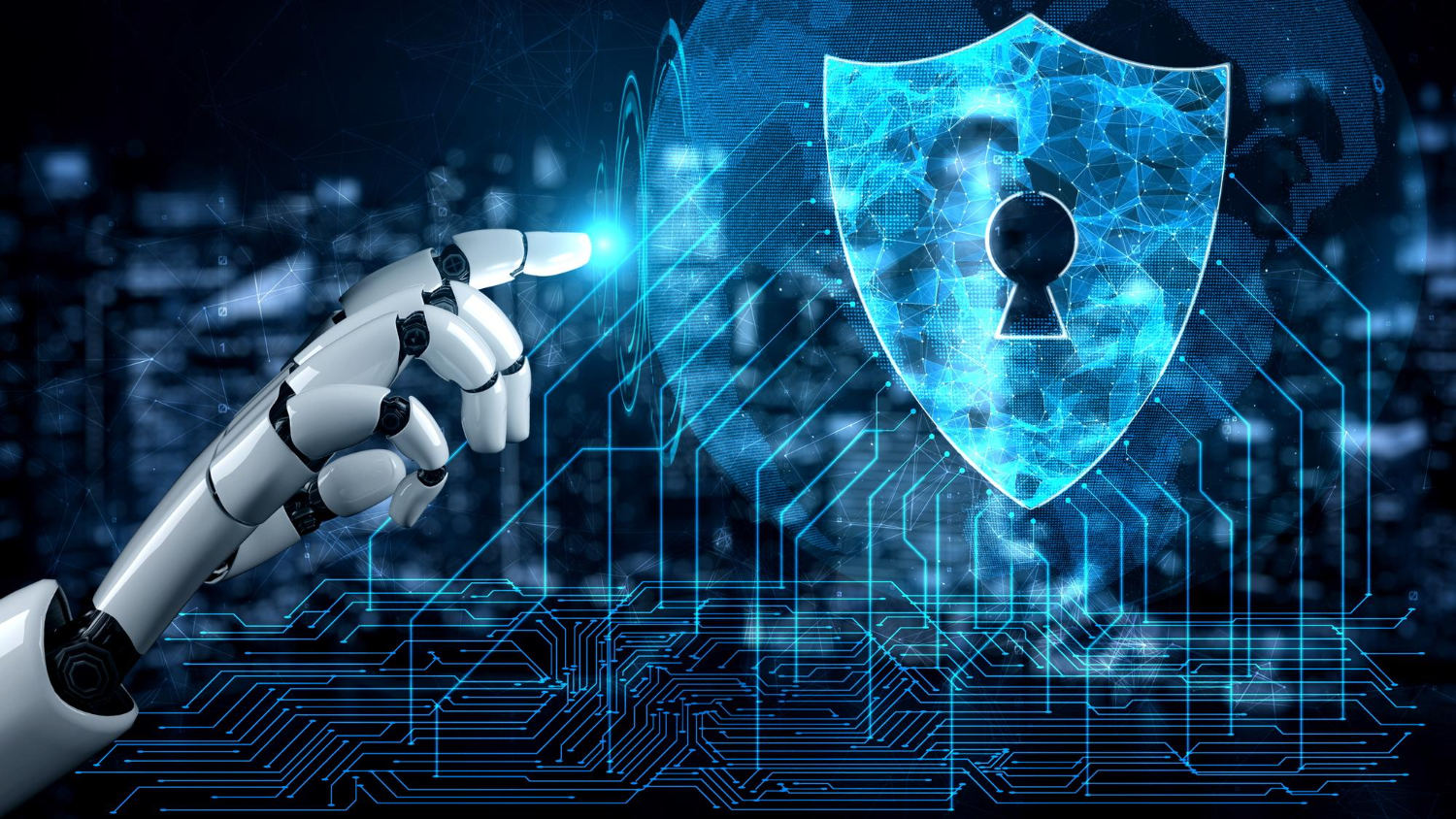AI (Artificial Intelligence) and cyber security are two rapidly evolving fields that have a profound impact on each other. As technology advances, so do the methods used by cyber criminals to exploit vulnerabilities and compromise sensitive information.
AI Advancements in Cyber Security
AI-driven technologies, particularly machine learning and deep learning, have bolstered cyber security defences. These intelligent systems can analyse massive volumes of data at unparalleled speeds, allowing for real-time threat detection and response. By recognising patterns and anomalies in network traffic and user behaviour, AI helps security professionals stay ahead of rapidly evolving cyber attacks. AI is also instrumental in predicting and preventing cyber threats. It can identify potential vulnerabilities in software code and systems, helping organisations patch and fortify their defences proactively.
AI can significantly assist cyber security experts in various ways, empowering them to be more efficient, proactive, and effective in protecting digital assets and data. Here are some ways AI can be a valuable ally for cyber security professionals:
- Threat Detection and Analysis: AI-powered systems excel at continuous monitoring of networks, endpoints, and digital assets, enabling the detection of suspicious activities and potential threats. By analysing vast amounts of data in real-time, AI can identify subtle patterns and anomalies indicative of cyber attacks. These patterns might be difficult for human operators to discern, allowing AI to act as a powerful early warning system against evolving threats.
- Behavioural Analytics: AI can establish a baseline of normal behaviour for users and systems within an organisation. This baseline enables AI to detect deviations and unusual activities that might suggest malicious intent. For instance, AI can identify insider threats by recognising unusual access patterns or suspicious user behaviour. Moreover, AI can help uncover zero-day attacks where traditional signature-based methods might fail, providing an additional layer of defence against previously unknown threats.
- Automated Incident Response: AI-driven incident response allows for swift and automated actions when threats are detected. Cyber security experts can define predefined response protocols, and AI can execute them in real-time. This includes blocking malicious IP addresses, isolating compromised devices, and implementing security measures to mitigate the impact of an ongoing attack. By automating certain response actions, cyber security experts can focus their efforts on more complex and strategic tasks.
- Improved Threat Intelligence: The vast amount of threat intelligence data available can be overwhelming for cyber security experts to manually process and analyse. AI comes to the rescue by efficiently sifting through diverse sources, including public information, dark web forums, and security feeds, to provide up-to-date and relevant information about emerging threats and the latest tactics used by cyber criminals. This timely intelligence helps security teams stay ahead of potential threats.
- Faster Vulnerability Management: Identifying vulnerabilities in complex systems and software can be a time-consuming process. AI-assisted vulnerability management streamlines this task by automating code and configuration analysis. AI can quickly identify potential weaknesses, allowing cyber security experts to prioritise and address critical issues promptly, reducing the window of exposure to potential exploits.
- Enhanced Phishing Detection: Phishing attacks continue to be a major cyber security concern. AI can enhance phishing detection by analysing email content, sender behaviour, and URL structures. It can recognise patterns that often indicate phishing attempts, thus reducing the risk of employees falling victim to these social engineering attacks.
- Adaptive Defence Strategies: Cyber attackers constantly evolve their tactics, requiring a dynamic and adaptable defence strategy. AI-driven cyber security systems continuously learn from new data and threat intelligence, enabling them to update their defence mechanisms accordingly. This adaptability is crucial in countering the ever-changing landscape of cyber threats.
- Reduced False Positives: Traditional security systems often generate numerous false positives, leading to wasted time and resources. AI-powered threat detection can significantly reduce false positives by employing advanced algorithms and behaviour-based analysis, ensuring that cyber security experts can focus their efforts on addressing genuine threats promptly.
- Advanced Malware Detection: AI-powered antivirus solutions can detect and stop sophisticated malware, even when no specific signature or pattern is available. By leveraging behavioural analysis and machine learning, AI can recognise previously unseen malware and zero-day threats, providing a proactive defence against rapidly evolving cyber threats.
- Streamlining Security Operations: AI’s ability to automate repetitive tasks and streamline security workflows brings efficiency to cyber security operations. It can handle data analysis at scale, rapidly processing and correlating information from multiple sources, freeing up cyber security experts to concentrate on strategic decision-making and addressing complex security challenges.
- Adversarial AI Defence: As AI becomes more prevalent in cyber security, attackers might attempt to manipulate or deceive AI-powered security systems. However, AI can also be deployed on the defender’s side as an adversarial defence mechanism, actively working to detect and neutralise attacks attempting to exploit AI vulnerabilities.
AI’s integration into cyber security empowers experts to be more proactive, efficient, and effective in safeguarding digital assets and data. By harnessing AI’s capabilities for threat detection, behavioural analytics, incident response, and adaptive defence, cyber security professionals can stay ahead of the ever-evolving cyber threat landscape and better protect organisations from potential attacks. While AI plays a crucial role, human expertise remains essential for strategic decision-making, ensuring a harmonious synergy between AI and human intelligence in the ongoing battle against cyber threats.
AI and Cyber Criminals

AI’s advancement has not only benefited cyber security experts but also cyber criminals, providing them with powerful tools and tactics to carry out more sophisticated and targeted attacks. Just as AI enhances defence capabilities, it also poses significant challenges for cyber security due to its potential misuse in the hands of malicious actors. Here’s how AI impacts cyber criminals:
- Automated Attacks: AI allows cyber criminals to automate various stages of their attacks, making them more efficient and scalable. Tasks like scanning for vulnerable targets, crafting personalised phishing emails, and distributing malware can be automated, allowing cyber criminals to target a larger number of victims in a shorter time.
- Spear Phishing: AI enables cyber criminals to launch highly targeted spear-phishing attacks. By analysing vast amounts of data from social media, public records, and other sources, AI can generate highly convincing and personalised phishing messages that are difficult for recipients to identify as fraudulent.
- Evasion Techniques: Cyber criminals can leverage AI to create more sophisticated evasion techniques. For instance, AI-powered malware can adapt its behaviour to evade detection by traditional security solutions, thereby increasing its chances of successfully infiltrating a target system.
- Social Engineering: AI can aid cyber criminals in crafting more convincing social engineering schemes. By analysing patterns in human behaviour and language, AI can simulate realistic conversations, making it harder for victims to recognise they are interacting with a malicious entity.
- Password Cracking: AI algorithms can speed up the process of brute-forcing passwords, allowing cyber criminals to gain unauthorised access to user accounts and systems more easily.
- AI-Generated Fake Content: AI can be used to create realistic fake audio, video, and text content. Cyber criminals can use this technology to fabricate false information, deceive individuals, or damage reputations.
- Data Manipulation: AI can manipulate large datasets quickly and accurately. Cyber criminals can use this capability to alter records, falsify information, or disrupt data integrity, leading to significant consequences for organisations and individuals.
- AI-Driven Botnets: AI-powered botnets can automate attacks, coordinate distributed denial-of-service (DDoS) assaults, and distribute malware across multiple devices and networks simultaneously.
- Exploiting AI Vulnerabilities: As AI is integrated into cyber security defence mechanisms, cyber criminals might seek to exploit vulnerabilities in AI models or deceive AI-powered security systems, evading detection and gaining unauthorised access to sensitive data.
- AI-Enhanced Malware: AI can be used to create more potent and adaptive malware. AI-powered malware can analyse its environment and adapt its behaviour to avoid detection, making it challenging for traditional security solutions to identify and mitigate the threat effectively.
- AI-Assisted Fraud: AI can analyse vast datasets to identify potential targets for fraud or financial scams, allowing cyber criminals to refine their techniques and select victims with higher chances of success.
To counter the threats posed by AI-enabled cyber criminals, cyber security professionals must continually improve their defences and remain vigilant. This includes developing AI-driven security solutions capable of detecting and neutralising AI-generated attacks, leveraging AI for threat hunting and intelligence gathering, and implementing robust security awareness programs to educate users about potential AI-driven scams and social engineering attempts.
Ethical Implications of AI in Cyber Security
The incorporation of AI in cyber security has ushered in a new era of threat detection, incident response, and vulnerability management. However, as AI’s role in these processes expands, it brings forth significant ethical considerations that demand careful attention to ensure the responsible and ethical use of AI in the realm of cyber security.
Privacy Concerns
AI-powered cyber security systems often process vast amounts of user data to detect patterns and anomalies indicative of potential threats. While this data analysis is crucial for effective threat detection, it raises privacy concerns. Organisations must ensure that user data is handled responsibly, adhering to strict privacy regulations and obtaining appropriate consent for data processing.
Data anonymisation and encryption techniques can be implemented to protect user privacy while allowing AI algorithms to operate effectively. Transparency in data collection and usage practices is essential to gain user trust and confidence in AI-driven cyber security systems.
Bias and Fairness
AI models are only as unbiased as the data they are trained on. If historical data used to train AI algorithms contains biases, these biases can be perpetuated in decision-making processes. This can lead to discriminatory outcomes, affecting certain individuals or groups more negatively than others.
To address bias in AI cyber security, data collection practices must be carefully audited, and AI models must undergo rigorous testing to identify and mitigate bias. Diversity in the datasets used for training AI algorithms can help minimise bias and ensure that security decisions are fair and equitable.
Transparency and Explainability
The “black box” nature of some AI algorithms can be concerning, particularly when these models make critical cyber security decisions. Lack of transparency in AI decision-making processes can lead to distrust and hinder the ability to identify and address potential issues.
Ensuring transparency and explainability in AI cyber security is vital to build user trust and facilitate effective human oversight. Techniques like interpretable machine learning and model explainability methods can shed light on AI decision-making processes, making it easier for cyber security professionals to understand and validate the decisions made by AI systems.
Human Oversight and Responsibility
As AI-powered cyber security systems automate more tasks, it is essential to strike a balance between machine-driven decisions and human oversight. While AI can handle repetitive and time-consuming tasks efficiently, human experts bring critical judgment, creativity, and contextual understanding to complex situations.
In critical scenarios or when facing novel threats, human intervention becomes essential to assess the situation comprehensively and make nuanced decisions. Organisations should establish clear guidelines for human intervention in AI-driven processes and ensure that ultimate responsibility lies with human cyber security professionals.



